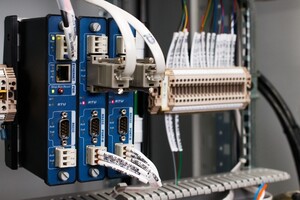Checking-in on remote assets

With broadcast’s geographically spread assets and multiple process that all generate massive amounts of data, key to ensuring these improvements is being able to capture and interpret it in real-time.
In this article, Philippe Aretz, channel sales director at Ovarro, previously Servelec Technologies, explains why the deployment of remote telemetry unit (RTU) and SCADA systems has been essential to support the roll out of mobile communications and broadcasting mediums, especially those in remote locations.
One of the most important demands for telemetry systems in the broadcast sector is to establish a reliable communication network. Safety and efficiency are key priorities, too, whilst organisations have legitimate concerns about security breaches.
The benefit of using RTUs in the broadcast and telecoms sector is that it helps to reduce downtime and enables more efficient preventative maintenance scheduling. This is achievable due to the RTU system’s ability to provide accurate, real time data; allowing asset management teams to make better, more informed decisions.
In addition, because RTUs do everything locally, it means if communications break down, they continue to run and act autonomously, whilst maintaining a historical log, and reporting back later. In remote, harsh locations where many masts are located, communication is liable to fail regularly, although RTU’s can manage this. For instance, data acquired by the RTU can be used to support maintenance decisions, and to verify that performance obligations are being adhered to.
RTUs can be deployed on a wide range of equipment from masts, control panels and security measures through to electrical gear. Once in place, they provide remote monitoring of electrical current, temperature, smoke, power and humidity. The unit relays this information to the cloud where it can be analysed and trended, providing operators with a high degree of predictive maintenance capabilities. Where power supply from the grid is not available, they can incorporate intelligent management of power consumption as well as battery or solar power options.
The real value of an RTU is that it can perform autonomous control in real time and then report to SCADA on current status. Operators at the SCADA interface can ‘supervise’ the operations by setting new KPIs (Set Points) or updating instructions (open/close this, start/stop that, for example) for RTUs to then act upon and manage locally.
These developments in RTU functionality make them particularly suited to the broadcast sector because they offer resilience to the site environment, have an ability to operate with minimal drain on local power resources, whilst retaining the processing power to perform local control algorithms autonomously.
RTUs in the European cellular network
Our TBox RTU technology has been used by one of our partners in Europe on a project with a major European telecoms company as part of its commitment to improve quality of service to its customers. The main scope of the project was to optimise and replace obsolete RTUs. They were also looking to optimise and control the equipment and installation of a large set (several hundreds) of broadcasting centres with a single solution.
The company required a telemetry solution that provided modularity, sturdiness, compact size, open and standard telecontrol protocols, logic programming and strong cyber security capabilities. Following a careful evaluation of several alternative options, they specified TBox MS and TWinSoft configuration tool because it is a highly resilient and secure automation platform suitable for their critical and demanding SCADA applications.

In combination, these technologies allow users to complete their applications and dynamically control communication, alarms, data logging and logic locally or remotely in a fully-secure environment.
Protocols — IEC-60870-5-104, SNMP, Modbus RTU/TCP were chosen to allow the management of downstream communication with the equipment, sensors and broadcasting devices, as well as to interact upstream with the SCADA control technology. These kinds of solutions are suitable for mobile telephony infrastructure, audio-visual broadcasting networks, smart grid technology, security and the IoT.
This customer went on to deploy the technology in over 250 sites and continues to use it in other locations.
‘Smart’ telecoms assets
Companies in the broadcast sector are demanding more, and ‘smarter’, information and as a result, RTUs will be deployed in greater numbers. It’s worth bearing in mind that currently most RTUs are only used for operations, although they can support maintenance teams, health and safety initiatives and environmental management.
As networks grow and increase in size through more connected devices, managing the greater number of assets will become increasingly difficult through traditional, non-technology methods such as scheduled service engineer visits. And, mergers between companies that span continents and sharing of assets such as masts will require a technological approach because central management will increasingly require remote data acquisition.
Set against this is the fact that RTUs are a cost-effective way of collecting large amounts of data, meaning a relatively low investment cost for the benefits they deliver will make them a more attractive proposition on a wider range of assets.
With broadcast’s geographically spread assets and multiple process that all generate massive amounts of data, key to ensuring these improvements is being able to capture and interpret it in real-time. Latest, ruggedised RTU technology focuses specifically on that, helping operators meet their investor and customer commitments.
The author is Philippe Aretz, channel sales director at Ovarro, previously Servelec Technologies.
Comment on this article below or via Twitter @IoTGN
